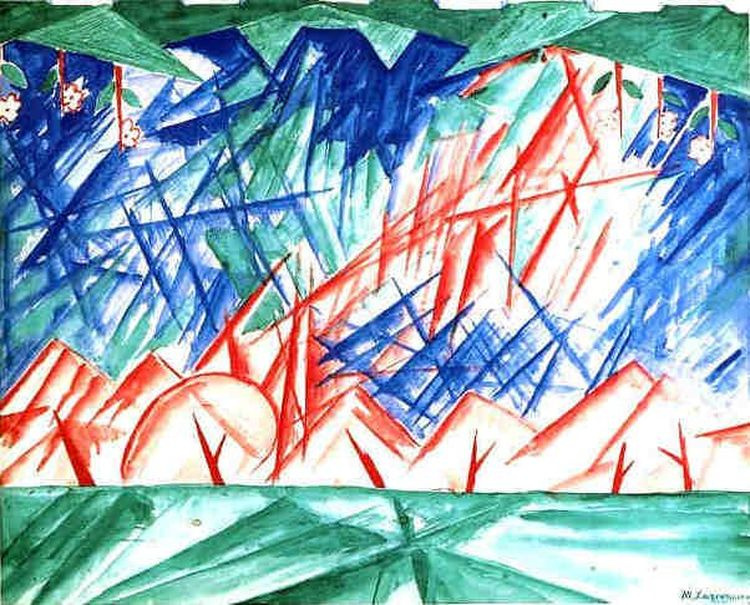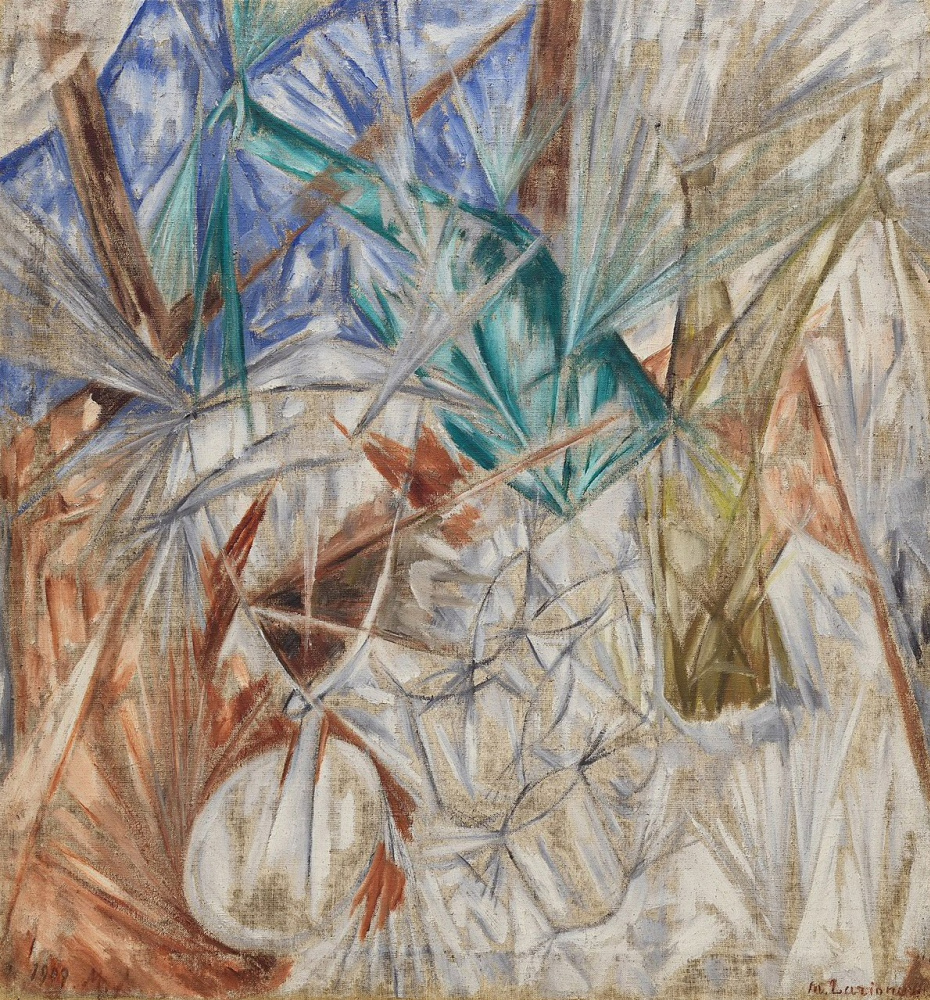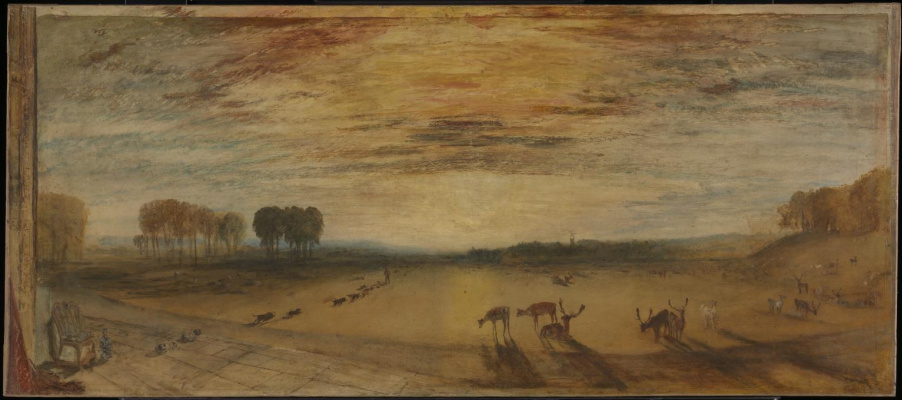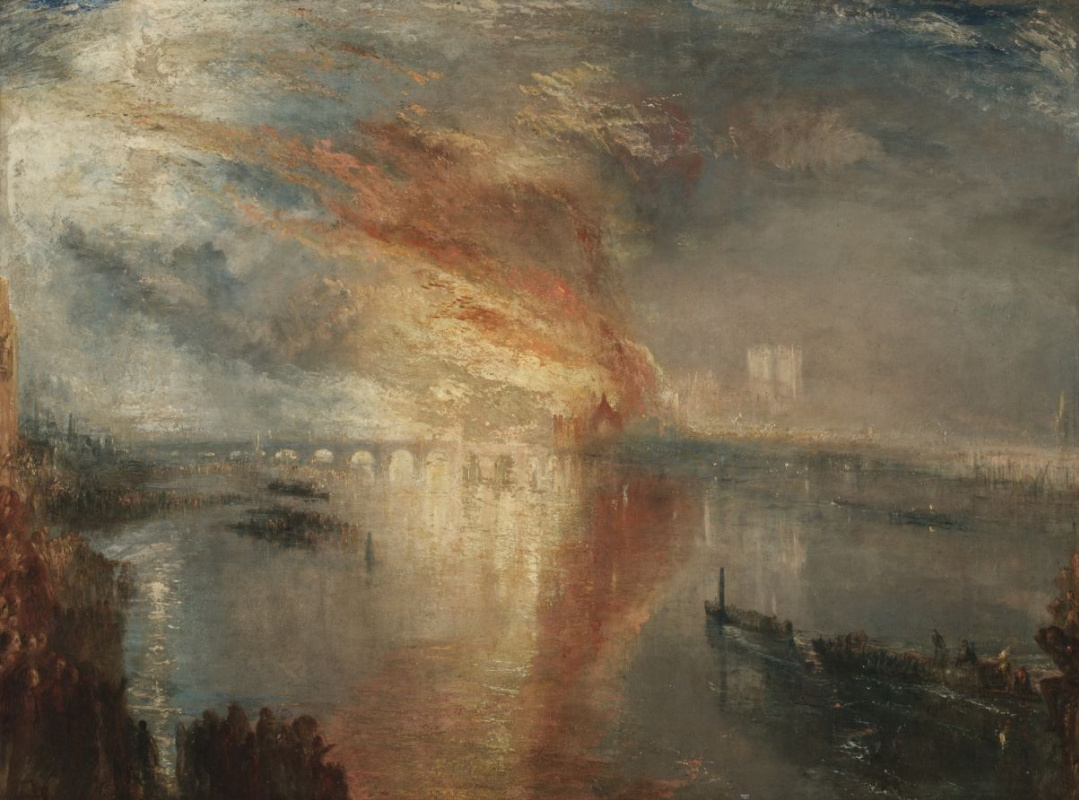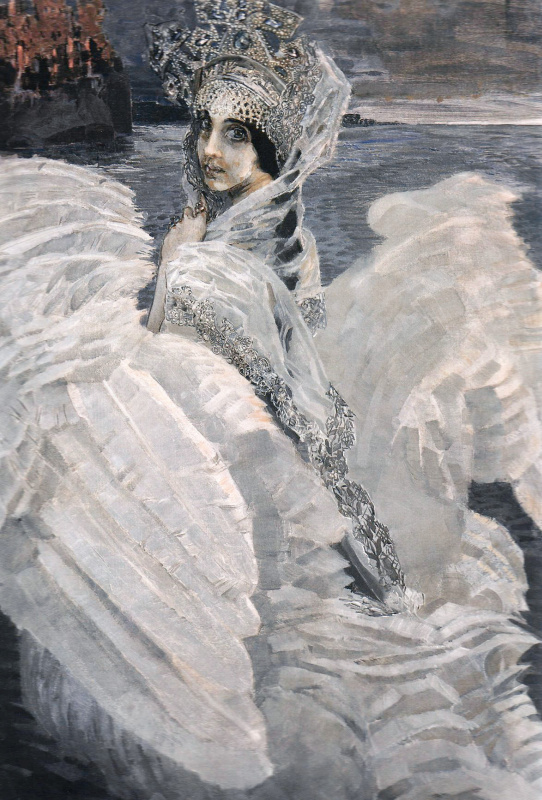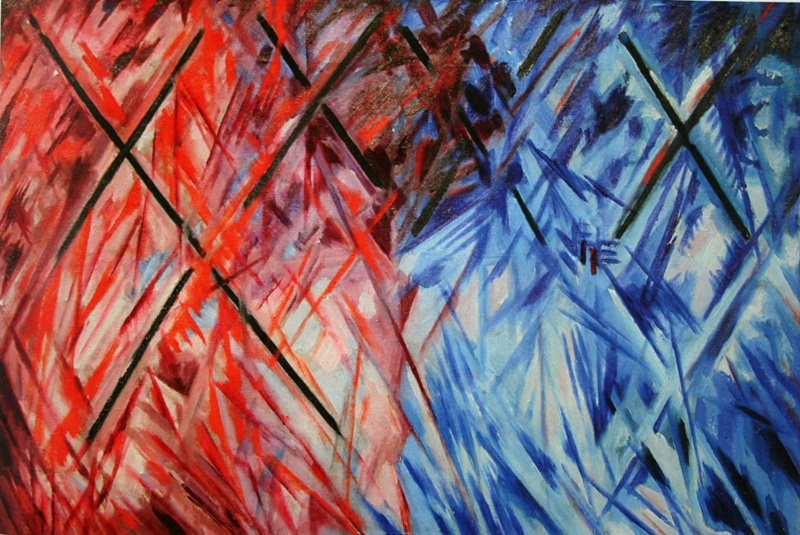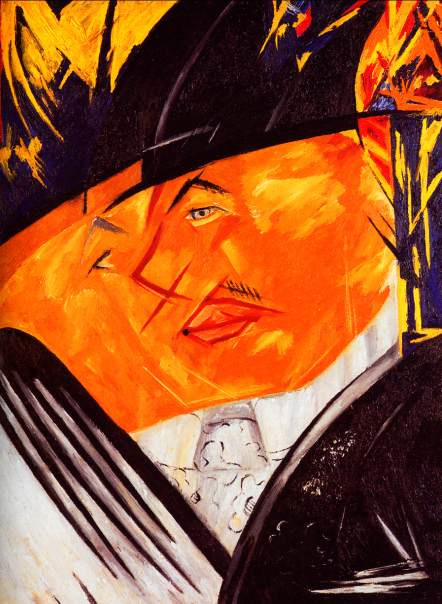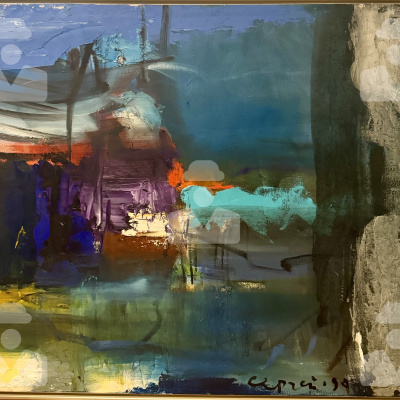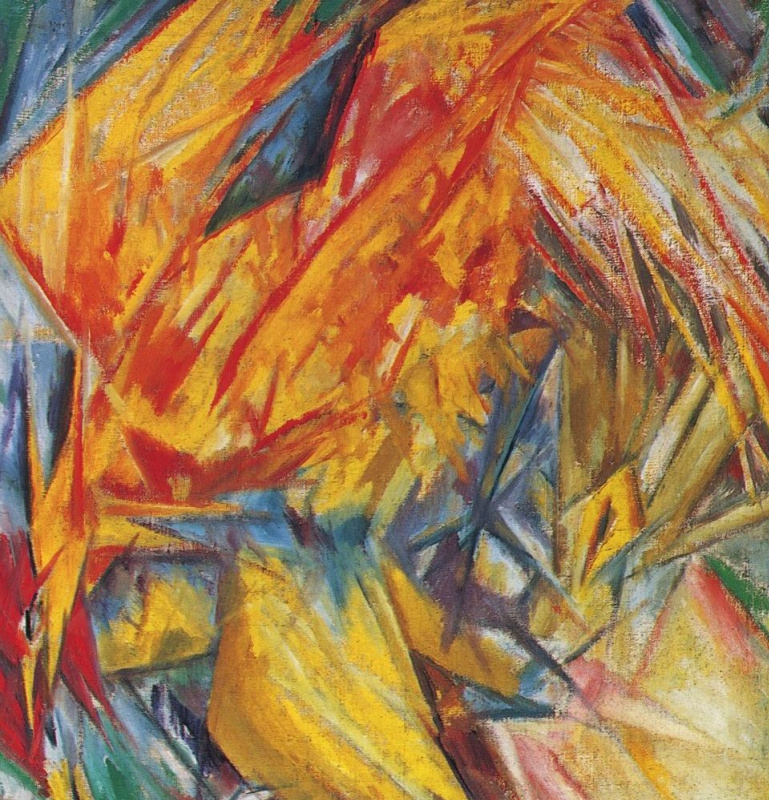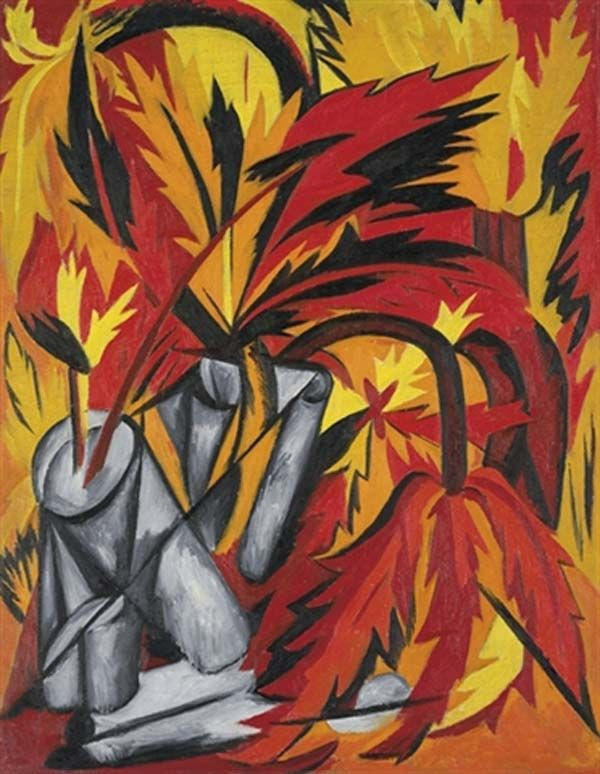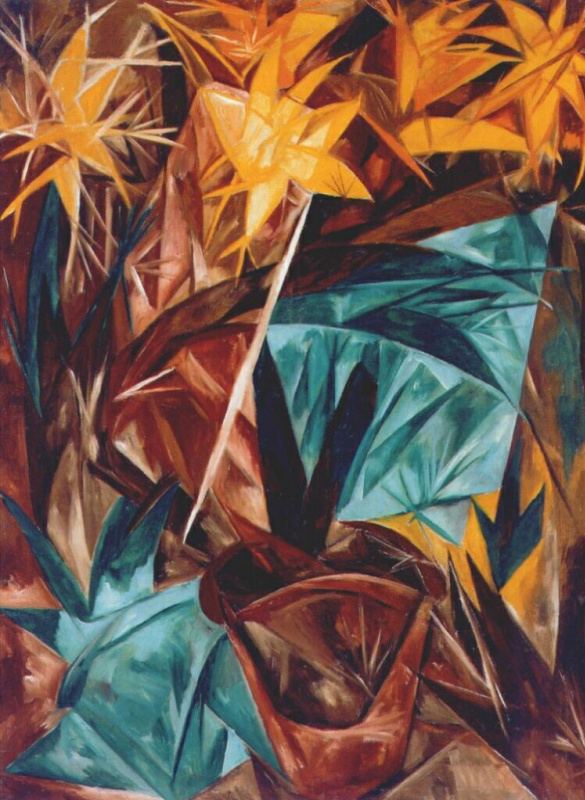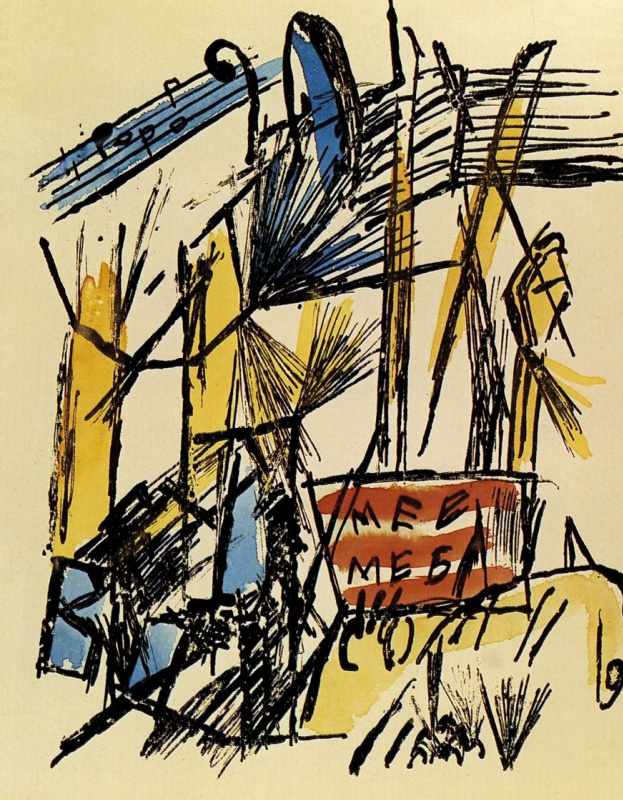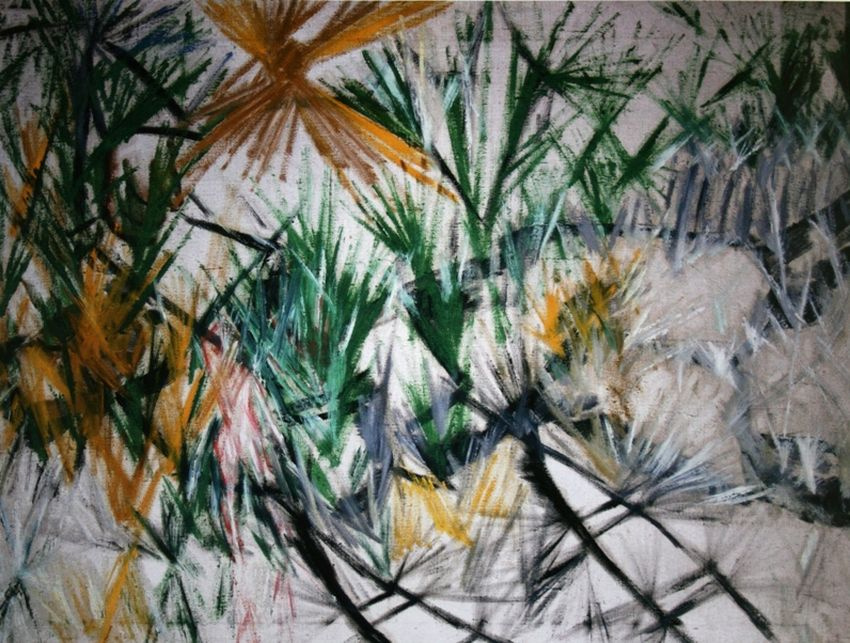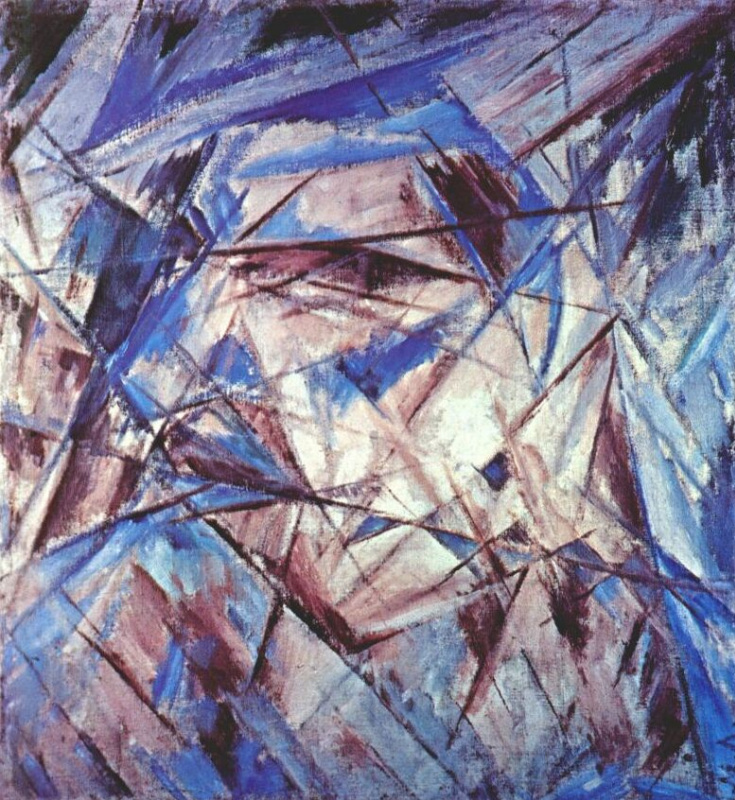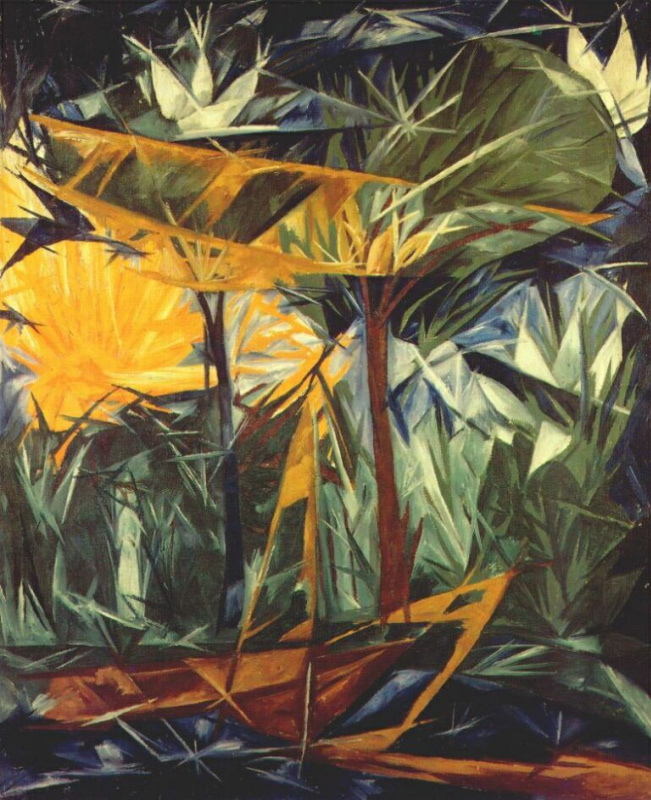Rayonism is the invention of Mikhail Larionov. This art movement created the foundation for the emergence of abstract painting in Russia, it pretty much became the first abstract ray in the realm of objectivity. Since our vision is arranged in such a way that we perceive not the objects themselves, but the rays reflected by them, then we must focus on the rays! This is how Mikhail Larionov decided and convinced his fellow artists, so that we can admire the bright, shining, in all senses, energetic pictures of the Rayonists.
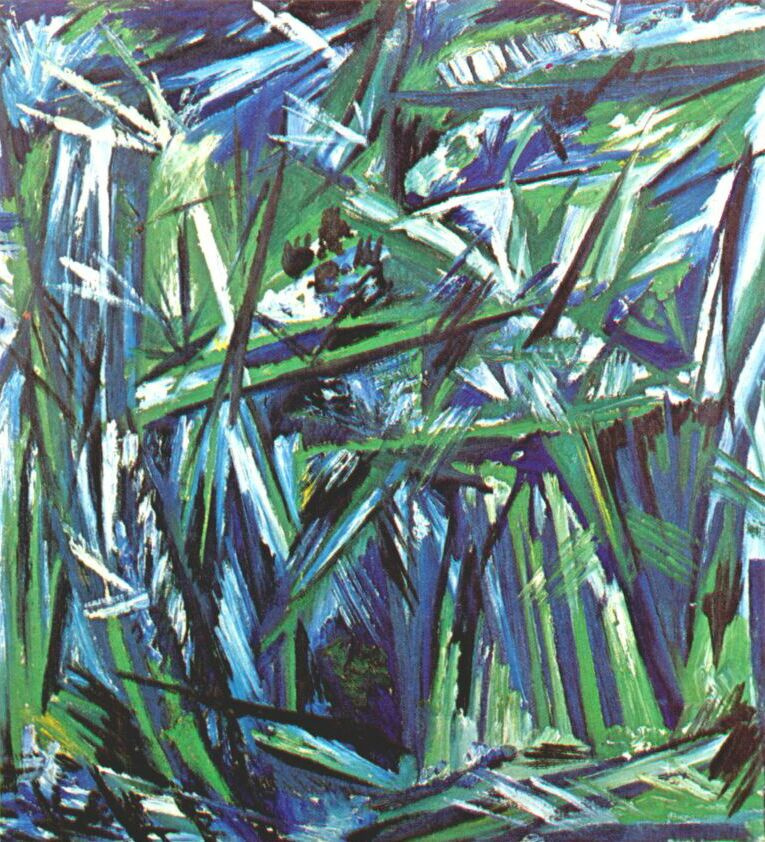
Blue ray
1915, 52×68 cm
Radiant art: where from and where to
"We do not declare any fight, since where can we find an equal opponent?! The future is ours," Mikhail Larionov, the founder of Rayonism, explained the situation in the painting arena. Modesty was not the long suit of the creators of the fourth dimension of painting, the rayonnant energetic one. And rightly so, they had other advantages.The "ray of Rayonism" flashed in 1909, at an exhibition in the Moscow Society of Free Aesthetics, where Mikhail Larionov’s Glass painting was presented.
Glass
1909, 104.1×97 cm
What did Rayonism draw forth? Well, all the abstractionism, at least the Russian. What preceded it? It is believed that the very first herald of the future radiant art was the exhibition of William Turner visited by Larionov in 1906. The same Turner, who anticipated future trends, filled the mists of Albion with such a passion of colour that the Impressionists and the Post-Impressionists and, which is relevant in this case, the Rayonists, emerged from these mists.
Petworth Park, with Church of Tillington away
1830, 60×145.7 cm
A fire in the houses of Parliament on 16 October 1834
1835, 92.5×123.2 cm
Mikhail Vrubel. The Swan Princess, 1900.
Another interesting version of the origins of Rayonism is offered by the artist Pavel Mansurov, who knew Larionov well. He recommends looking for the first shoots of future Rayonism in Vrubel. In his youth, Larionov is known to have worked under his leadership for some time. Of course, we won’t find direct quotes from Vrubel in Rayonism, but some echoes are quite possible.
Demon sitting
1890, 116.5×213.8 cm
Rayonism among other avant-garde movements
In Russia, the beginning of the last century was generous with experiments in the field of art. Let’s try to figure out how Rayonism differs from other -isms of those years.Rayonism still starts from objects, but it repels them. The surrounding reality is only an excuse for crossing the rays, which are the object of interest for the Rayonist artist. Not only objects, but also our feelings, impressions, sensations and ourselves, everything is displayed in the form of rays, according to Larionov. He dreamed that someday even a device would be created that would make it possible to assess how strong is the love of those who love each other…
The so-called "realistic Rayonism" is considered an individual section, in which the object serves as a foothold.
Radiant lines
1911, 52.5×78.5 cm
Larionov’s Radiant Lines (above) is a pure abstraction, whereas the radiant portrait of Larionov by Natalia Goncharova (left) is based on a very definite object.
The Rayonists recognized Cubism, Futurism and Orphism
, believing radiant painting to be the pinnacle of artistic art and a synthesis of these trends.
Rayonism is an image of the rays felt by the artist. This is where we move even further from the so-called "objective reality", because it is not about painting rays instead of an object, there is even no excuse for "radiant objectivity"! These are the rays seen by the artist, that is, the artist’s impressions. This allowed Mayakovsky to define Rayonism as a Cubist version of Impressionism. In other words, Rayonism is the artist’s impression of reality, expressed through the rays he depicts.
Radiant paintings get under the skin with this particular feature — the combination of the structure inherent in Cubism, and the whirlpool of sensations, impressions that come from Impressionism .
Rayonism is an image of the rays felt by the artist. This is where we move even further from the so-called "objective reality", because it is not about painting rays instead of an object, there is even no excuse for "radiant objectivity"! These are the rays seen by the artist, that is, the artist’s impressions. This allowed Mayakovsky to define Rayonism as a Cubist version of Impressionism. In other words, Rayonism is the artist’s impression of reality, expressed through the rays he depicts.
Radiant paintings get under the skin with this particular feature — the combination of the structure inherent in Cubism, and the whirlpool of sensations, impressions that come from Impressionism .
Vladimir Mayakovsky believed that Rayonism was a Cubist interpretation of Impressionism.
The main values of the Rayonists were proclaimed colour combinations, saturation, richness of colour, colour masses ratio, intensity of perception, following energy vectors. Radiant paintings have a special spatial structure. They are definitely not voluminous. But they are not planar, as in Neo-Primitivism, and not a superposition of planes, as in Orphism. The rays seem to penetrate the canvas in all directions at once, and the result is creation of a volumetric intersection of planes.
Cock. Radiant Study
1912, 68.8×65 cm
"This is almost the same as the mirage that appears in the hot air of the desert and paints distant cities, lakes, oases in the sky — Rayonism erases the boundaries that exist between the plane of the picture and nature," Larionov himself gave this definition.
At that, it should be noted that the radiant works by Natalia Goncharova, Larionov’s wife and like-minded person, are more diverse in terms of form, her rays are not always rays, they can create rounded arcs, bend, bring depth and volume to the canvas.
At that, it should be noted that the radiant works by Natalia Goncharova, Larionov’s wife and like-minded person, are more diverse in terms of form, her rays are not always rays, they can create rounded arcs, bend, bring depth and volume to the canvas.
Weaver
1913
The Rayonists stopped fighting the old art, and they considered it their main difference from the Jack of Diamonds. They did not oppose the old with the new, but created a completely different sphere. As modern business coaches would say, they left the red ocean of competition and went into the blue ocean of opportunities, where they simply have no competitors. Went to fill the pictures with the radiance of their rays. By the way, around the same time, in France, the Fauvist Maurice Vlaminck said: "I wanted to burn the School of Fine Arts with my cobalt and cinnabar; I wanted to express my feelings with my brush, without thinking about what was already painted before…".
The postulates fixed by the Rayonists were immediately designated as continuously changing and fluid. Larionov in particular and the theory of Rayonism in general denied such a phenomenon as objectively existing ideals. Pictures glide, beams are reflected, everything changes every minute. It was their attitude not only towards their own creations, but also towards art in general. Larionov stated: "There is no eternal beauty. If you show Raphael’s Madonna to some African native, he will make boots out of it, because it is well oiled."
Rayonist exhibitions
The formal age of Rayonism was short. After the Larionov’s painting of 1909, the Target exhibition organized by the Donkey’s Tail* society in 1913 included radiant paintings. The exhibition displayed works (created in different styles) by Natalia Goncharova and Mikhail Larionov, Mikhaïl Le Dentu and Kazimir Malevich, Marc Chagall and Alexandr Shevchenko.It was followed by an exhibition of 1914 under the self-explanatory title "No. 4 — Futurists, Rayonists, Primitives". Actually, it was the last official event of the Rayonists.
However, in the same year, in the Paris gallery of Paul Guillaume, Goncharova and Larionov exhibited their "radiant" works among others. This was the official end of Rayonism. Was it really?
* Donkey’s Tail
Larionov, Goncharova, Tatlin, Malevich, Le Dentu and some other artists left the Jack of Diamonds group in 1910 and organized their own movement, with even more trenchant name, Donkey’s Tail. The first exhibition of Donkey’s Tail took place in 1912. The "tails" did not want to follow the West, but chose the East as their reference point; moreover, more that of Russia than mysterious Asia. At the Target exhibition, Donkey’s Tail proclaimed Rayonism the pinnacle of painting. However, the group disintegrated soon after the exhibition. In addition to the presentation of Rayonism, the "tails" discovered to the world the Georgian self-taught primitivist Niko Pirosmani. Target was his only lifetime exhibition.
Larionov, Goncharova, Tatlin, Malevich, Le Dentu and some other artists left the Jack of Diamonds group in 1910 and organized their own movement, with even more trenchant name, Donkey’s Tail. The first exhibition of Donkey’s Tail took place in 1912. The "tails" did not want to follow the West, but chose the East as their reference point; moreover, more that of Russia than mysterious Asia. At the Target exhibition, Donkey’s Tail proclaimed Rayonism the pinnacle of painting. However, the group disintegrated soon after the exhibition. In addition to the presentation of Rayonism, the "tails" discovered to the world the Georgian self-taught primitivist Niko Pirosmani. Target was his only lifetime exhibition.
Raised by Larionov’s ray
If we admit that Larionov’s rays became the springboard that allowed future Russian abstractionists to break away from the surrounding reality, to go beyond space and time, then it turns out that Rayonism is an inexhaustible source for the emergence of new styles and trends, new names and new idols.Perhaps the meaning of any article on art is not to give all the answers, but to leave viewer eventually alone with the picture, throwing away the knowledge gained, and let him feel that everything could be different. Therefore, having declared Larionov the source of Russian abstractionism, in the end we will unexpectedly present an alternative, non-standard vision. The researcher Nikolai Punin believed that both Kandinsky's theorized visionaries and the fundamental pointlessness of Malevich's Suprematism were deeply alien to Larionov. Proceeding from this, Punin believes that the creation of Rayonism, non-objective, but infinitely connected with nature, with life, became an act of opposing the rationalized non-objectiveness of Cubism and Suprematism and "was the fruit of very subtle realistic comparisons".
Rayonism: a Crib
Artists who worked in this direction: Mikhail Larionov, Natalia Goncharova, Mikhaïl Le Dentu, Sergey Romanovich, Alexandr Shevchenko.Examples of "radiant" paintings:
You are an expert if: you are brave enough to see signs of Rayonism in works that are attributed to Cubism or Futurism — avant-garde
artists were not afraid to mix and shake newly invented styles.
You are a layman if: you consider Rayonism to be images on X-ray films or samples of vector computer graphics.
What a story! In 2008, the rays from the Flowers still life by Natalia Goncharova turned into rays of glory: at the London Christie’s auction, the painting was sold for $ 10.9 million, making Goncharova the most expensive artist at that moment.
Title picture — Natalia Goncharova, Green Forest. This canvas seems to laugh at our attempts to understand what Rayonism is, and is both a pure abstraction and the green forest declared in the title.
Author: Aliona Esaulova
You are a layman if: you consider Rayonism to be images on X-ray films or samples of vector computer graphics.
What a story! In 2008, the rays from the Flowers still life by Natalia Goncharova turned into rays of glory: at the London Christie’s auction, the painting was sold for $ 10.9 million, making Goncharova the most expensive artist at that moment.
Title picture — Natalia Goncharova, Green Forest. This canvas seems to laugh at our attempts to understand what Rayonism is, and is both a pure abstraction and the green forest declared in the title.
Author: Aliona Esaulova






